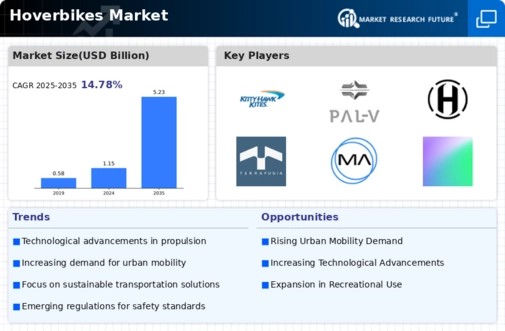Regulatory Support and Frameworks
The Hoverbikes Market is benefiting from evolving regulatory frameworks that aim to facilitate the integration of hover technology into existing transportation systems. Governments are increasingly recognizing the potential of hoverbikes as a solution to urban congestion and are establishing guidelines to ensure safety and compliance. For instance, regulations regarding airspace management and pilot licensing are being developed to accommodate this new mode of transport. This regulatory support is likely to encourage investment and innovation within the industry, as companies seek to align their products with emerging standards. As a result, the market may see accelerated growth, with estimates suggesting a market size of over 2 billion dollars by 2030.
Consumer Interest and Market Awareness
The Hoverbikes Market is witnessing a rise in consumer interest and awareness, which is crucial for market expansion. As media coverage and public demonstrations of hoverbikes increase, potential customers are becoming more informed about the benefits and capabilities of this innovative transport mode. This heightened awareness is likely to translate into increased demand, as consumers seek alternatives to traditional vehicles. Furthermore, the emergence of ride-sharing platforms that incorporate hoverbikes could further stimulate interest and acceptance among the general public. Market Research Future indicates that consumer interest in personal aerial vehicles is on the rise, suggesting a promising future for the hoverbike segment, with potential market growth rates of 12% over the next few years.
Rising Urbanization and Mobility Needs
The Hoverbikes Market is poised for growth due to rising urbanization and the increasing demand for efficient mobility solutions. As urban populations swell, traditional transportation systems are becoming increasingly strained, leading to a search for alternative modes of transport. Hoverbikes offer a unique solution by providing rapid transit options that can bypass traffic congestion. This demand is particularly pronounced in densely populated metropolitan areas, where the need for innovative transportation solutions is critical. Market analysts predict that the demand for urban mobility solutions, including hoverbikes, will drive a significant portion of the market's expansion, potentially reaching a valuation of 3 billion dollars by 2028.
Technological Innovations in Hoverbikes
The Hoverbikes Market is experiencing a surge in technological innovations that enhance performance and safety. Advancements in battery technology, such as lithium-sulfur batteries, are increasing flight times and reducing charging durations. Additionally, improvements in materials science are leading to lighter and more durable structures, which are crucial for maneuverability and efficiency. The integration of artificial intelligence in navigation systems is also becoming prevalent, allowing for autonomous flight capabilities. As these technologies mature, they are likely to attract a broader consumer base, potentially increasing market penetration. The market is projected to grow at a compound annual growth rate of 15% over the next five years, driven by these innovations.
Environmental Concerns and Sustainable Transport
The Hoverbikes Market is also influenced by growing environmental concerns and the push for sustainable transport solutions. As awareness of climate change and pollution increases, consumers and governments alike are seeking alternatives to traditional fossil fuel-powered vehicles. Hoverbikes, particularly those powered by electric propulsion systems, present a cleaner option that aligns with sustainability goals. The shift towards eco-friendly transportation is likely to enhance the appeal of hoverbikes, as they can significantly reduce carbon emissions compared to conventional vehicles. This trend may lead to increased investment in research and development, further propelling the market forward, with projections indicating a potential market growth of 20% annually.

















Leave a Comment